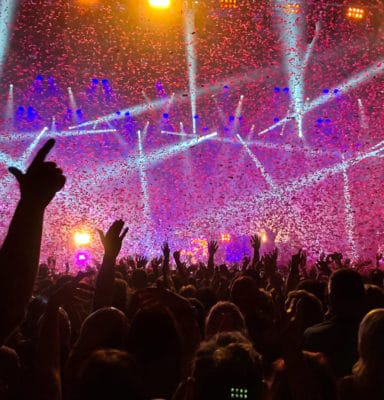Beacon technology has become a solid performer for tracking the time, date, and location of an attendee. The information is used to understand attendee behaviors and preferences. In the next wave of event-beacon innovation, however, planners will use beacons to enhance the attendee experience.
 Journey tracking
Journey tracking
Even the most organized attendees can’t remember every place they visited during an event. But, beacons placed throughout a conference or trade show can help software do the remembering for them. Companies are starting to package content (videos of sessions or performances, data sheets, checklists, slides, etc.) from specific stops on the attendee journey. Attendees can then access the content after the event and share it with colleagues.
Personalized welcomes
One potential use of wearable beacons involves interaction with a display screen. For example, as attendees (VIPs perhaps) approach the entrance to a ballroom wearing a beacon-enabled badge or wristband, a display screen can welcome them by name. If display screens are too impersonal, the wearable beacon can push the wearer’s name to a handheld device so that a human can greet him by name.
Customized tours
Beacons can help attendees using beacon-enabled apps to navigate a space intentionally. They can also serve up content to complement a specific journey. So, imagine that an attendee at an automobile show is only interested in hybrid vehicles. Using his app, he can request that he only be directed to booths with hybrid vehicles. He can also elect to receive only information on hybrid vehicles. This example of using beacons to enhance the attendee experience aligns the physical space with the attendee’s specific interests.
Services
Beacon technology can transform the way that attendees order services and even register for the event. For example, individuals arriving at an airport can go to a specially marked location. A link inside of a push notification delivered to their beacon-enabled app can let them register for the event or check into their hotels. Conference-goers can order their favor coffee drink while standing in line at the Starbucks. The app can automatically summon a taxi or Uber car when they leave the conference center.
Gamification
Scavenger hunts—a longtime staple of business-to-business events—require that players move from location to location searching for clues. With a beacon-enabled app, hunters can find locations more quickly and find the clues (via push notifications) more easily. Using beacons to enhance the attendee experience with game play can also make the production of a scavenger hunt less logistically challenging (no more signs with QR codes).
Networking
Beacons can help attendees understand whether others around them are good matches. A beacon-enabled app can notify users that a person who matches a certain profile (based on LinkedIn, for example) is nearby. This capability helps attendees find peers they already know or request meetings with individuals they would like to meet. In a very large event where the sheer numbers diminish the chances of meeting people, beacons can help jumpstart valuable conversations.
Beacon technology doesn’t configure itself. To be successful at using beacons to enhance the attendee experience, planners need to develop strategies. Contact the beacon experts at SmartSource Rentals to help you design an environment that gets your attendees talking.
